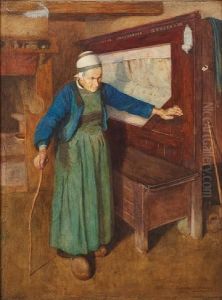Sidney Curnow Vosper Paintings
Sidney Curnow Vosper was a British painter born in 1866 in Stonehouse, Plymouth, Devon. He is best remembered for his watercolour paintings that often depicted Welsh and Breton subjects, showcasing his interest in Celtic heritage and culture. Vosper's education in art began at the South Kensington Art School, which laid the foundation for his later works. His artistic journey was further honed at the Académie Julian in Paris, where he was influenced by the French academic painting tradition and the burgeoning Symbolist movement.
Vosper's works are characterized by their detailed depiction of traditional costumes, architecture, and the daily lives of his subjects, rendered with a romantic sensibility that endeared them to viewers. One of his most famous works is 'Salem' (1908), a watercolour that features a Welsh woman in traditional dress attending a service at the Salem Baptist Chapel in Cefncymerau, Llanbedr, near Harlech, North Wales. This painting became iconic in Wales, symbolizing Welsh identity and pride, and was widely reproduced. The intricacy with which Vosper painted the textiles and the chapel interior reflects his interest in capturing the essence of Welsh culture.
Throughout his career, Vosper exhibited his works at various prestigious venues, including the Royal Academy and the Paris Salon, gaining recognition and accolades for his contributions to British art. His travels to Brittany and Wales greatly influenced his artistic output, allowing him to immerse himself in the cultures that he depicted with such fidelity. Vosper's legacy is not only in his paintings but also in his contribution to the preservation of Celtic culture through his art.
Sidney Curnow Vosper passed away in 1942. Today, his works are considered important in the study of British and Welsh art history, representing a bridge between the traditional and the modern, and celebrating the cultural heritage of the Celtic peoples. His paintings continue to be admired for their beauty, attention to detail, and cultural significance.
